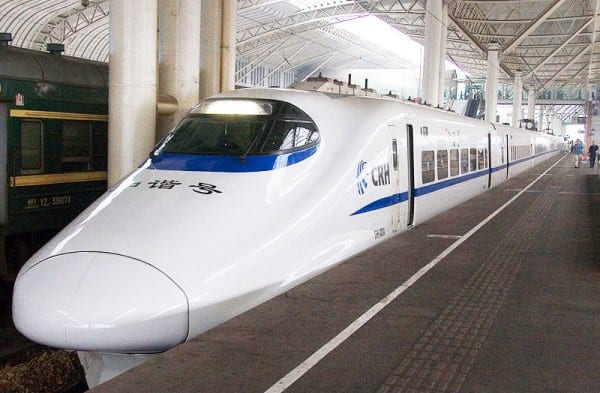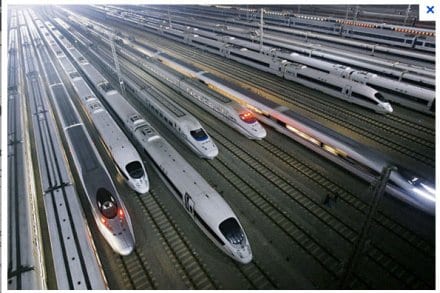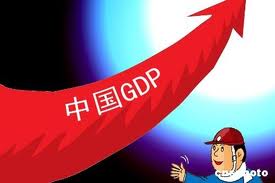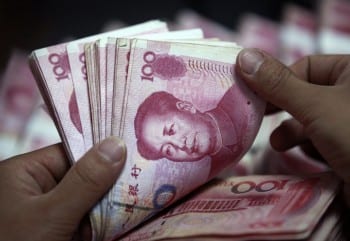Crowning the Dragon: World’s Top Economy
Stephen Lendman
[I]t was just a matter of time before China surpassed America as the world’s leading economy based on purchasing power parity (PPP). It’s an exchange rate between currencies measured by the cost of a representative basket of goods in one country v. another.
Surprisingly, China’s growth happened faster than experts expected. In 2011, IMF economists estimated it would overtake America in 2016. At the time, they projected its PPP GDP at $18,975.7 trillion v. $18,807.5 trillion for America.
They now estimate America’s 2014 PPP GDP at $17.4 trillion v. $17.6 trillion for China. The speed of China’s growth is remarkable. As recently as 2005, its economy was less than half the size of America’s.
READ EDITOR’S NOTE BELOW. CLICK THE SHADED BAR 
[learn_more caption=”China’s economic growth may be a success story, but hold the champagne.”] The desirability of such an economic stance has been discussed now for decades, including among bourgeois economists who clearly see the limits and costs of (but do not sufficiently criticize) the capitalist approach to the good society. As the Wiki somewhat mildly notes,
Development of steady state economics (sometimes also called full-world economics) is a response to the observation that economic growth has limits. Macroeconomic policies in most countries, particularly those with large economies as measured on a GDP scale, typically have been officially structured for economic growth for decades.[3] Given the costs associated with such policies (e.g., global climate disruption, widespread habitat loss and species extinctions, consumption of natural resources, pollution, urban congestion, intensifying competition for remaining resources, and increasing disparity between the wealthy and the poor), some economists, scientists, and philosophers have questioned the biophysical limits to growth, and the desirability of continuous growth.
In sum, China, after taking care of her self-defense needs in regard to her sovereignty, should lead in the establishment of a new type of economic system, one radically different from the destructive and ultimately unviable capitalist way.—P. Greanville[/learn_more]
By 2019, IMF economists expect it to be 20% larger based on PPP. Its phenomenon reflects overall emerging market growth v. developed ones. In 2007, they accounted for around half of global output. It’s now about 57% and rising. By the 2020s, it may approach, reach or surpass two-thirds.
Overall emerging market growth is extraordinary by any standard. Since 2007, it’s ninefold what developed nations achieved. Analysts call China’s growth over the past three and a half decades one of the greatest success stories in modern times.
It began in 1979 when Deng Xiaoping introduced economic reforms. He famously said: “Black cat, white cat. What does it matter what color (it) is as long as it catches mice.” The Congressional Budget Office (CBO) estimates China’s real GDP grew 19-fold in real terms from 1980 to 2011. Real per capital GDP increased 14-fold.
An estimated 500 million people were elevated out of poverty. Beginning in 1979, farmers got price and ownership incentives to sell crops freely on their own. At the same time, special economic zones were created to attract foreign investment, boost exports and attract high technology. Tax and trade incentives were offered.

China’s Hi Speed Rail system is among the fastest and best in the world. America’s rails —by comparison—are an international embarrassment.
Other reforms followed in stages. Economic policymaking was decentralized in several sectors. Especially trade. Provincial and local governments got economic control of various enterprises. Based on free market principles rather than central planning state control. Citizens were encouraged to establish businesses. Central regions and cities were designated open ones and development zones.
Doing so let enterprises experiment with free market reforms. Tax and other incentives were offered. Price controls on many products were gradually eliminated. Official policy aimed to identify ways to achieve maximum growth.
Deng called the process “crossing the river by touching the stones.” Economic crisis beginning in late 2007 impacted China greatly. Its GDP fell from 14.2% in 2008 to 9.2% in 2009.
In response, significant economic stimulus was introduced. So was expansive monetary policy. Domestic investment and consumption increased. Sharp slowdown was avoided.
In 2010, real Chinese GDP grew 10.4%. In 2011, it was 9.2%. In 2012, 7.8%. In 2013, 7.7%.
Industrial Bank in Shanghai chief economist Lu Zhengwei says “(i)t’s like Chinese medicine. If you don’t take it, you may have problems in the future.”
“But if you take it now, you cannot expect to regain your youth tomorrow.”
After three and a half decades of extraordinary growth, Beijing wants more sustainable higher-quality development instead.
Achieving it requires letting business have more say in allocating resources. It involves promoting greater domestic consumption at the expense of investments and exports.

The MagLev wind turbine, which was first unveiled at the Wind Power Asia exhibition in Beijing, is expected to take wind power technology to the next level with magnetic levitation.
At the same time, China’s economy is heavily dependent on growth. In 2013, capital formation accounted for 54% of it.
It exceeded consumption’s 50%. Net exports detracted 4.4% from overall growth.
Economist Tim Condon said he didn’t “see any evidence of a rebalancing last year.” Yet Beijing wants investment reined in.
In 2013, China’s fixed-asset investment grew 19.6%. It was the smallest increase in the past decade. It was slightly below a projected 19.8% rise. At the same time, $3 trillion in debt accumulated. Head of China’s statistics bureau Ma Jiantang calls it vital to check.
“In 2014, I believe reforms will continue to be a key driving force for economic growth,” he said. Slowdown to a sustainable level is vital. Better-quality development can follow. Changes can be instituted gradually. Without concern for inadequate job growth or perhaps losses at times.
Beijing will have more latitude to stabilize monetary policy. Risky lending can be curbed. According to IHS Global Insight chief China economist Brian Jackson:
“On the whole, the Chinese economy is performing well through its adjustment phase.”
Concerns about too much growth through transition to what’s more sustainable are unfounded, he believes. Average growth targets issued by 22 of China’s 31 local governments show downward revisions by nearly 1%. At the same time, China’s key commercial centers’ growth is mostly stable. Overall growth is declining modestly.
Reforms take time to produce results. China performed remarkably for decades. Economists expect continued strong results ahead. At a more sustainable level. Analysts attribute China’s growth to large-scale domestic and foreign investment, as well as impressive productivity gains. Economic reforms produced higher efficiency. Output was boosted. Increased resources became available for additional investment.

China historically maintained high savings. In !979, they were 32% of GDP. Economic reforms produced substantial household savings growth as well as corporate savings. As a percent of GDP, they reached 53.9% in 2010 compared to America’s 9.3%. High-level Chinese savings permit greater domestic investment.
Its gross domestic savings level far exceeds what’s needed for internal needs. China is a large net global lender. Productivity gains enabled greater economic growth. Especially in agriculture, trade, services and other formerly controlled government sectors.
By any standard, China’s growth over the past three and half decades has been extraordinary. It was just a matter of time before it became the world’s largest economy. Currently on a PPP basis. Ahead based on GDP by any measure. The dragon is No. One. It intends staying there and then some.
In contrast, IMF World Economic Outlook (WEO) data show world economic conditions “in the middle of a balancing act.”
“On the one hand, countries must address the legacies of the global financial crisis, ranging from debt overhangs to high unemployment,” said WEO. On the other, they face a cloudy future. Potential growth rates are being revised downward, and these worsened prospects are in turn affecting confidence, demand, and growth today.”
Crisis conditions since 2008 proved tougher to resolve than expected, IMF economists say. Interplay of negative forces caused downward growth revisions over the past three years. From 5.3% to 3.3% and heading south. Things are no different now. WEO data suggest “mediocre” growth ahead. Worse than forecast in July.

At the same time, forces operate differently in various countries. Global economic evolution is more “differentiated” than earlier. Central bank money printing madness keeps America and EU economies from collapsing. What can’t go on forever won’t. Free lunches last only so long. Day of reckoning time approaches. It won’t be pretty when it arrives. Irresponsible monetary policy prevents stimulative growth. Central bank governors pursue what never worked before sustainably.
Economic numbers are rigged to conceal it. Real growth requires dropping money on Main Street. Noted investor/philosopher king Jeremy Grantham bashes Fed policy justifiably. In an earlier commentary, he highlighted “runaway commodities, (zombi) banks back to life, homes destroyed, families evicted, and currency wars.”
He blamed Bernanke. “If I were a benevolent dictator,” he said, he’d limit Fed policy solely to maintaining price stability. He’d make sure the economy got enough liquidity to function normally. He’d “force (Fed governors) to swear off manipulating asset prices through artificially low rates and asymmetric promises.”
He referred to the Greenspan/Bernanke put. He’d eliminate “immoral hazard.” It’s immoral behavior, he said. It’s outsized excess. It’s grand theft. It bails out large banks, other financial giants and large investors. Doing so encourages imprudent risks. Winning is guaranteed. Regulatory checks are absent. Anything goes is policy.
Things persist irresponsibly. They do so “under the guise of ‘saving the system,’ ” said Grantham. Money manipulators have things their way. Monied interests control Western central bank policies. They’re served at the expense of popular ones. America’s economy is deplorable. Claims otherwise are false.
It bears repeating. Numbers are rigged to conceal house of cards conditions. They’re worsening, not improving. Virtually all global assets are overpriced. Bubble conditions exist. Grantham compared them to Einstein’s definition of insanity. The madness of repeating the same mistakes. Expecting a different outcome doesn’t work.
Last year, Grantham compared Fed policy to beating a donkey. He called it the 1% growing economy. “(H)e keeps beating it until it either turns into a horse or drops dead from too much beating,” he said. “We’ve been conned.” We’re manipulated to believe “debt is everything.” In 1982, it was one-and-a-quarter times GDP.
It’s more than triple that amount now. It has nothing to do with long-term growth. It’s an “accounting world. It’s paper,” said Grantham. “The real world is the quantity and quality of your people, and the quality and quantity of capital spending.”
“Are you building new machines? Are you being inventive?” Are you educating a new generation properly? “We’re in this death grip that only paper things matter.” Vital issues go unaddressed. Wealth is transferred upward. From most people to rich ones.
To Wall Street, not Main Street. Interest rates are outrageously low. Practically zero. Speculators benefit. Ordinary people lose out. Retirees lose vital income. Financial interests are served at the expense of the real economy.
Former Reagan budget director David Stockman said money printing madness and bailouts reflct the “most shameful chapter in American financial history.”
It’s grand theft by any measure. It wrecked the economy to benefit Wall Street, other corporate favorites and rich elites. It let popular needs go begging. It’s self-defeating. Protracted Main Street Depression conditions persist. Hard times keep getting harder. America once was sustainably prosperous. Today it’s in decline.
It’s thirdworldized. Outrageously corrupted. More kleptocracy than democracy. It’s unsustainable and then some. Money power in private hands doesn’t work. It’s been this way for over a century. Banker-controlled Fed policy loots America. It’s responsible for deplorable conditions. They include:
- unsustainable consumer debt;
- record budget and trade deficits;
- out-of-control national debt;
- record numbers of personal and business bankruptcies;
- millions of home foreclosures;
- depression level unemployment, poverty, homelessness and hunger;
- an unprecedented wealth gap between rich elites and ordinary Americans; and
- a hugely unstable economy lurching from one crisis to another.
A 1913 dollar isn’t worth a plug nickel today. At best about two or three cents. Wall Street planned it this way. It profits at the expense of ordinary Americans. It’s high time things changed. It’s more than ever vital to put money back in public hands where it belongs. It’s an idea whose time has come.
ABOUT THE AUTHOR
http://www.claritypress.com/LendmanIII.html
Visit his blog site at sjlendman.blogspot.com.
Listen to cutting-edge discussions with distinguished guests on the Progressive Radio News Hour on the Progressive Radio Network. It airs three times weekly: live on Sundays at 1PM Central time plus two prerecorded archived programs.

